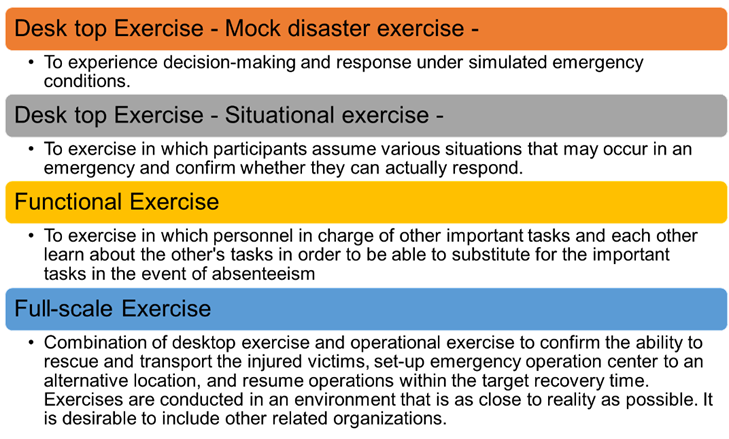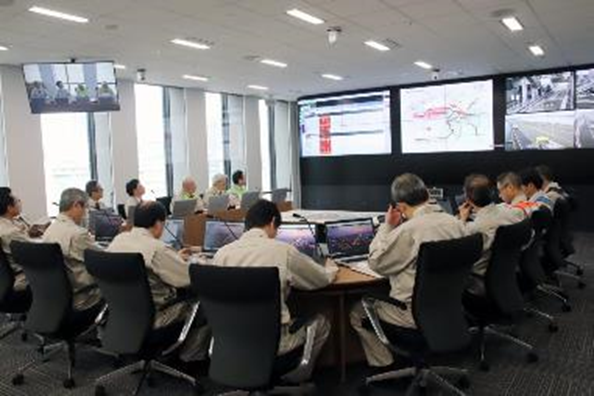
Disaster Management Manual
A manual for practitioners and decision makers!

Disaster Management Manual
A manual for practitioners and decision makers!
In order for disaster emergency response plans to be effective, it is important that everyone from the top management of road management to the front-line employees understand the mission required of road managers to maintain or quickly restore road functions, and that this mission is established as a "culture". For this purpose, it is essential to conduct exercises.
When conducting exercises, the following points are essential 1.
(1) To confirm that personnel ia assigned with a thorough knowledge of how to respond to emergencies.
(2) To experience and physically confirm the response in an emergency.
(3) To train the ability to respond to emergencies, including responses to unexpected situations.
(4) To verify and improve the emergency response manual.
(5) To include the exercise in coordination with a wide range of related organizations in the event of an emergency.
It is important to tailor the content of disaster emergency response exercise to the goal of the exercise, such as content confirmation and acquisition, decision making, and actual physical exercise. Figure 3.5.2.1 2 shows examples of implementation methods. In addition to periodic training (e.g., on an annual basis), it is also important to conduct exercises when there is a significant change in the organization of personnel due to system changes, personnel transfers, hiring, etc., and when the emergency response manual is reviewed and improved.
In order to evaluate the effectiveness of the exercise, it is necessary to clearly define the objectives and decide in advance how to evaluate the degree of achievement.

In the event of a disaster, it is necessary for those involved in road maintenance to take prompt emergency and recovery measures, and for disaster management organizations, including road-related organizations, to work in close cooperation to ensure harmonious responses. In order to achieve this, it is necessary to decide on emergency response, recovery response, and coordinated response in the event of a disaster, based on past disaster experience and disaster simulations, and to make them effective through regular exercises. For this purpose, disaster simulation exercises are the most important means 3.
The purpose of disaster exercises for road-related organizations is to verify and confirm the countermeasures taken by the organizations in the event of a disaster7.
(1) Through the disaster exercises, the functions of the organizational structure of road-related organizations in normal times are confirmed and evaluated, and their effectiveness is verified.
(2) Through disaster exercises, to confirm the appropriate division of roles among road-related organizations in the event of a disaster, and effective measures for cooperation and collaboration, and to strengthen cooperation.
(3) In conducting disaster exercises, focus on discovering weak points and issues in disaster prevention plans, etc., in order to continuously improve them.
(4) Since self-improvement and self-development of disaster management personnel during normal times are directly linked to the improvement of society's ability to respond to disasters, disaster management personnel shall be given opportunities to review and evaluate their daily efforts.
In addition, to maximize the effectiveness of disaster exercises, it is desirable to establish the following basic policies for the exercises.
(1) Exercises should contribute to the improvement of disaster response capabilities based on past disasters.
To improve the ability to respond to the many issues related to disaster prevention measures that have been learned from previous disasters, the content of the training should include emergency response to various possible damages and wide-area response by multiple related organizations.
(2) Promotion of practical and effective exercises
The most important aspects of the training, such as the setting of the situation, the assumption of damage, and the items to be taken as emergency measures (so-called scenarios), will be more practical and assume the worst possible situation.
(3) Promotion of prior education and training
To take appropriate actions when a disaster occurs, each person needs to be able to correctly imagine the situation when a disaster occurs. Enhance the daily self-education and self-development of those in charge of disaster prevention.
(4) Conduct exercises with the participation and cooperation of many entities
To promote disaster reduction measures that transcend organizational boundaries, the implementation of exercises in which many entities participate and collaborate will enhance mutual complementarity.
(5) Strengthen cooperation among disaster prevention-related organizations.
Road-related organizations and disaster prevention-related organizations need to cooperate with each other closely, collect accurate information, and take prompt and appropriate actions based on it.
(6) Implementation of objective analysis and evaluation of exercises
After the completion of the training, objective analysis and evaluation of the training should be conducted through analysis of problems identified during the scenario creation process, exchange of opinions among participants, and listening to the opinions of training observers and external experts to clarify issues, etc.
(7) Promotion of planned and systematic training
In addition to systematic preparation and implementation of exercises throughout the year, the content of exercises will be implemented in a way that allows for systematic verification and confirmation, and efforts will be made to systematically improve disaster response capabilities. Figure 3.5.2.2 shows a photo of the disaster and emergency exercise of a highway company.

To prevent the effectiveness of disaster management response capabilities from declining and emergency response manuals from becoming obsolete, large-scale exercises that simulate emergencies should be conducted on a regular basis (at least once a year) to inspect the state of disaster management and emergency response, including whether emergency response plans really work and whether they are insufficiently functional, and to make regular improvements based on the evaluation results.